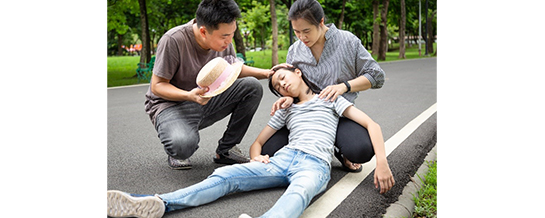How to Care for Your Child with a Fainting Episode (Vasovagal Syncope)
This leaflet will provide you with information about a fainting episode.

What is Fainting?
Fainting (also known as Syncope) is a temporary and sudden loss of consciousness with loss of body strength, followed by complete recovery in a few minutes.
Fainting happens when the blood flow to the brain slows down for a short period. When a person faints, they usually fall over or lie down; this makes it easier for the heart to pump more blood to the brain than standing.
Fainting in children is quite common; up to one in five children experience at least one episode before 15 years. These episodes can be caused by:
- Dehydration,
- Sitting for a long time
- Standing for a long time
- Fear
- Hot environment
- Sight of blood
- Stressful situations
- Hot shower.
What is a Vasovagal Syncope?
- The most common type of fainting in children is Vasovagal Syncope, caused by a reflex of the nerves that causes either sudden widening of the blood vessels in the legs or a slowing of the heart rate, or both.
- Vasovagal Syncope generally tends to be harmless.
- Rarely, syncopal episodes could be because of heart problems, anaemia or low blood sugar.
What are the signs and symptoms of Vasovagal Syncope?
Before fainting, a child may experience some warning signs such as:
- Dizziness,
- Problems with eyesight,
- Voices sounding far or muffled,
- Feel nauseous.
- The child may also look very pale during the fainting episode
If your child does not lie down immediately when these signs happen, he/she lose consciousness (faints) and fall over. Your child will often recover fully within a few minutes.
How Is Vasovagal Syncope diagnosed?
- The doctor will ask a few questions about your child’s health and examine your child.
- Your doctor will decide if more testing or blood tests are needed. Sometimes an electrocardiogram (ECG) or blood tests can be helpful but is not required with every fainting episode.
- Diagnosis of vasovagal Syncope is recognized by the usual symptoms and normal examination results.
- If the symptoms are typical of vasovagal Syncope and your child’s examination results are normal, no further tests are needed.
- In some situations, when an underlying cause is suspected, your child will be referred to a specialist
How Is Vasovagal Syncope treated?
- Treatment of fainting or syncopal attack depends on the underlying cause.
- Most of the time, simple actions at home can be enough
- Your doctor will advise you if your child needs any further treatment
Prevention
To prevent syncopal episodes, the following actions can be useful
- Encourage your child to drink plenty of fluids to avoid dehydration
- Add adequate amounts of salt to the meals
- Encourage your child to eat three meals a day, especially breakfast
- Encourage your child to Wear compression socks
If your child experiences the warning signs, they should immediately take the following actions to avoid loss of consciousness and fall:
- Lie down flat with the legs raised (on a chair or against a wall).
- Sit down as soon as the warning signs occur.
- If your child is in a public place and unable to lie or sit down, they can squat down until they feel better
- When feeling better, advise them to get up carefully.
- If signs return, they should continue the sitting/lying/squatting position.
When should I seek medical advice?
Seek medical advice if:
- Your child experiences fainting with loss of consciousness for the first time so that the doctor can assess them and give you a plan.
Go to the Emergency Department or call 999 if your child:
- Faints /loss of consciousness without any warning symptoms
- Experiences a lengthy period of loss of consciousness (more than five minutes)
- Faints during physical exertion or sporting activities
- Experience’s chest pain
- Experiences Palpitations- a feeling that your child’s heart beats faster, skips beats or have extra heartbeats.
- Have a history of heart disease
- Have a history of sudden unexplained death or sudden death due to heart condition in family members less than 40 years of age
- Have a History of a family member with a pacemaker

